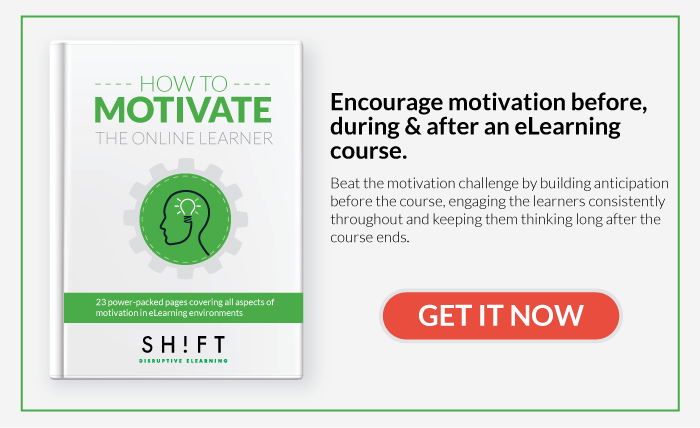Crafting an eLearning course is no small feat. Between coordinating with subject matter experts, aligning with business goals, and understanding your audience, there's plenty on your plate.
So, why should you consider adding storytelling to the mix? The answer lies in the innate human connection to stories.
Stories have been a powerful medium for centuries, captivating our minds and emotions. They shape our perceptions, influence our decisions, and define our identities.
In today's digital age, the significance of stories hasn't waned. As noted in Psychology Today, our brains may not have evolved as rapidly as technology, but stories remain our bridge, helping us resonate with the myriad of digital messages around us.
By weaving storytelling into your eLearning courses, you're not just adding another layer. You're enhancing the learning experience, making it more engaging and, ultimately, more effective.
How Do Stories Create Emotional Engagement?
Let's be honest: who actually enjoys digging through a boring manual when we can just ask our buddy or office mate? Show us a fancy car, and we might go, "Cool." But throw in a pitch about packing up the entire family (yes, even little Timmy) along with all the picnic gear? Suddenly, we're thinking, "Maybe I do need a new car." And don’t even get us started on rooting for the underdog. It's the emotions, the connection, that reel us in. It's about seeing ourselves in the story, the hero, the situation.
So, let's dive into why stories can take an eLearning course from "meh" to "wow":
1- Make Them Care About Your Content
Deep down, we've all got a bit of that wide-eyed kid inside of us. Who doesn't love a good story? We root for the hero, we gasp at their daring adventures, and we can't help but hope the villain gets their comeuppance. It's that emotional pull of the narrative that keeps us hooked.
By intertwining stories into your eLearning courses, you tap into those feelings, fostering an emotional bond with your learners. When they're emotionally invested, they're not just passively absorbing information. They're eager to learn, to dive deeper.
Actionable Tip: Next time you're developing content, think of a relatable story or scenario that ties into your main topic. It could be a real-life example, a fictional narrative, or even a personal anecdote. Not only will it make your content more engaging, but it'll also make the learning experience more memorable.
2- Keep Them Coming For More - Stories Whet Our Curiosity
Ever found yourself glued to a book, flipping page after page way past bedtime? Or binge-watching a series because you just have to know what happens next? That's the magic of a captivating story.
When you embed your eLearning content within a gripping narrative, learners aren't just passively clicking through; they're genuinely invested. Spice things up with a hint of mystery, a sprinkle of cliffhangers, and a tease of what's next. Not only are they engaged, but their brains are also buzzing, actively piecing together the story and predicting the next twist. This active engagement is miles ahead of the yawn-worthy, memorize-and-forget approach.
Actionable Tip: When planning your next eLearning module, think like a storyteller. Start with a compelling problem or challenge, introduce relatable characters, and pace the content with mini-cliffhangers. Maybe end a module with a question or scenario that gets addressed in the next one. That way, learners are always eager to click on the next lesson.
3- Make Content More Relatable - Stories Help Learners Feel Identified
At the heart of every person is an innate desire for connection. It's why we're drawn to stories—tales of individuals, their challenges, triumphs, and journeys. Especially the ones that feel familiar, like they could be about us. When designing eLearning, it's crucial to remember this intrinsic human trait. Instead of bombarding learners with cold, impersonal data or generic examples, craft narratives that center around characters and situations they can recognize from their own lives.
Stories, by their very nature, breathe life into content. They transform abstract concepts into tangible scenarios, making the learning journey more visceral. When learners encounter content that feels familiar, it fosters a deeper connection, prompting them to think, "Hey, I've been there," or "I know someone just like that." This personal identification doesn't just enhance engagement—it ensures retention. Because while numbers and facts might fade, stories, especially those we see ourselves in, tend to linger in our minds.
Actionable Tip: Dive into the world of your learners. Understand their daily challenges, cultural nuances, and personal aspirations. When designing your next eLearning course, integrate these insights to develop story-driven scenarios or case studies. You could even consider running a brief survey or focus group with your target audience to gather real-life anecdotes. This way, you're not just teaching—you're telling their stories, making every lesson resonate on a profoundly personal level.
4- From Passive Learners to Active Doers: Inspire Them to Take Action!
While facts and data might inform, it's stories that truly inspire. Think about it: a compelling narrative does more than just hold our attention—it tugs at our emotions, leaves lasting impressions, and most importantly, compels us to act. By intertwining eLearning with relatable stories, where the protagonist's journey mirrors that of the learner, you unlock a potent tool of persuasion. When learners feel that personal connection, it becomes more than just passive consumption of information. It transforms into a call to reevaluate, to change behaviors, and to shift mindsets.
Actionable Tip: Next time you're crafting eLearning content, think beyond the information you're delivering. Consider the change you want to inspire. Start with a relatable protagonist facing a challenge and take your learners on that journey of transformation. By the end, they shouldn't just know something new—they should feel empowered to act on it.
Why Do Stories Amplify Learning Effectiveness?
Ever wonder why stories have such a profound impact on learning? It's not just children who benefit; adults, too, absorb information more effectively when presented in a narrative format. Stories have a unique way of stimulating our brains, reaching places that raw data and endless slides simply can't touch. For the corporate learner, swamped daily with presentations and data charts, a story offers a refreshing change—a spark of curiosity and a renewed desire to dive deeper into the content.
Let's delve into why stories elevate the instructional quality of eLearning courses:
1- Today's Learners Crave Real-world Connections
Today's corporate learners are pragmatic. They're motivated by outcomes and real-world applications. Simply dazzling them with flashy content won't cut it; they're looking for the "what's in it for me?" factor. When your course mirrors their daily challenges and experiences through storytelling, it adds tangible relevance. Learners can immediately see how the course will address their work challenges, enhance their skills, and potentially propel their careers forward.
Also read: Would You Take Your Own eLearning Course?
2- Make Your Content Stick with Stories!
Think back to childhood: fairy tales, fables, and comic book adventures. Those narratives remain vivid in our minds. Now, try recalling that middle school history lesson. Not as clear, right? That's the power of storytelling. Research highlights that a whopping 63% of individuals retain information when it's wrapped up in a story, compared to a mere 5% from standard presentations. So, if you want your content to be memorable, embed it in a narrative.
Let's consider a corporate training module on ethical decision-making. Instead of simply presenting company guidelines and rules about ethics, imagine weaving a tale about "Jenna," a mid-level manager facing a moral dilemma. She's pressured by an important client to bend a few rules for a lucrative deal. The story can chronicle Jenna's internal struggles, the advice she receives from colleagues, and the eventual decision she makes. By the end of the module, learners aren't just familiar with the company's ethics policy; they've also emotionally journeyed through the challenges of upholding it in real-world scenarios. This story-based approach ensures that employees don't just understand the rules, but they also remember and internalize the significance behind them.
Read: Make It Hard to Forget: 6 Principles to Help Your Learners Remember Anything
3- Simplify Complex and Abstract Concepts
Stories don't just narrate; they illuminate. Through the journey of a character and the situations they navigate, learners gain a clear blueprint for action. Abstract concepts can be hard to grasp, but when framed within a story—using relatable anecdotes and analogies—they become much more digestible.
Take visual metaphors, for instance. These are storytelling gold. They take lofty, intangible ideas and ground them in visuals that resonate. By showcasing unseen connections or highlighting patterns, these metaphors transform the abstract into something immediately understandable.
Using stories to elucidate complex concepts can be highly effective in a workplace context. Here are some workplace-related topics where storytelling can shine:
-
Project Management: Instead of just outlining the principles of agile methodology, tell a story of a team transitioning from traditional methods, facing challenges, and how they overcome them using agile techniques.
-
Change Management: Narrate a tale about a company undergoing a significant digital transformation, with characters resistant to change and how they're eventually won over by understanding the benefits.
-
Data Security: Instead of just listing rules about password protection and phishing threats, spin a narrative about an employee who almost compromised the company's data and the measures taken to prevent such a situation in the future.
Read: Why More Instructional Designers Should Harness the Power of Visual Metaphors
4- Avoid Boredom and Break Monotony
Starting your eLearning course with a gripping story can instantly combat the drowsiness of routine. Why? Because a riveting tale engages our brain differently than standard content. It’s not just about processing facts; it’s about journeying through a narrative. These narratives not only stimulate various parts of the brain but also hold our attention in a way that ensures we're fully immersed, reducing the chances of missing key details.
Imagine an eLearning course on workplace safety. Instead of starting with statistics on accidents, begin with a story of "Alex," a dedicated employee who overlooked a minor safety guideline, leading to unexpected consequences. As learners follow Alex's journey, they're not just learning about safety protocols; they're emotionally connecting with the importance of each regulation.
5- Think Experience: Link Theory to Practice
Stories are intuitive.While charts and graphs might require a tutorial, stories are universally understood. Their inherent structure is familiar, allowing learners to naturally absorb the content without getting bogged down by the format. By using stories in training, you're letting participants focus on the core message, seamlessly linking theoretical knowledge to practical application.
Here are some examples:
-
Transformational Leadership: Start with introducing the theory that transformational leaders inspire and motivate through vision and enthusiasm. Then, narrate the journey of "Aisha," a department head, who manages to transform a previously disengaged team. She paints a vision of what they can achieve together, leads by example, and celebrates small victories, turning theory into tangible results. After the story, ask participants to draft a brief vision statement for their respective teams, emphasizing what they hope to achieve in the next quarter.
-
Conflict Resolution: After discussing the theoretical aspects of effective communication and active listening, delve into the story of "David," a project manager. David finds two key team members constantly at odds. Through the narrative, demonstrate how he applies active listening techniques, ensures both parties feel understood, and guides them towards a collaborative solution, thus showing theory in action. Afterward, facilitate a role-playing exercise where participants practice active listening in pairs, with one sharing a work-related challenge and the other reflecting back what they've heard.
Also read: 10 Things Modern L&D Professionals Should Be Doing
To learn more about how to integrate storytelling in your eLearning courses, download



